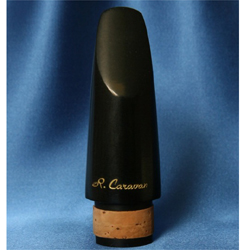Ron Caravan Clarinet Mouthpiece
Clarinet Mouthpieces

-
Ron Caravan
Clarinet Mouthpiece
A highly refined proprietary facing curve in consort with its distinctive interior design make the Caravan clarinet mouthpiece an especially attractive alternative for symphonic and classical chamber-music performance. Its design and specifications provide for a highly consistent mouthpiece that features an uncommon blending of tonal beauty, projection, and responsiveness.The essential four measurements along the facing curve that have been common (or nearly so) to most popular symphonic mouthpieces over the past many decades are also common to this mouthpiece, but the attention to detail along the curve is considerably greater. Virtually all clarinet facing curves that are produced by machine, by hand, or by a combination of both can have significantly different measurements at places along the curve that fall between the four conventionally measured points, and where measurements are not typically checked during production or refacing. When the Caravan clarinet mouthpiece facing is shaped, 16 points along the curve (a length of less than three-quarters of an inch) are checked and made to conform to very precise numerical specifications, some of which hold the key to responsiveness, tonal consistency, and tonal control at all volumes.
With an interior design that produces a well-balanced harmonic spectrum, a compatible precision facing curve that enables excellent control and response, and somewhat wider side rails that virtually eliminate that common and unwelcome low-register reed "buzz," the Caravan clarinet mouthpiece embodies a highly desirable set of potential advantages for the serious professional clarinetist or advancing clarinet student.
An especially advantageous characteristic of this mouthpiece is that it can accept maximum air for the most intense musical passages without loss of control or "center" in the sound_that is, it is less inclined to "spread" (assuming mature tone-production skills, especially good tongue-position voicing). With compatible reed strength, the mouthpiece can also provide for soft dynamics and gradual decay to silence without significant air noise.
FACING BASICS: Tip opening: 1.08 mm (or "108" in traditional parlance) at the very tip of the mouthpiece (not at the inside of the tip rail as most hand-held gauges measure tip opening). Length of curve: c.34 as measured on the standard "glass direct reading gauge" with the 0015 feeler gauge.
-
- Category: Clarinet Mouthpieces
- Item: 075640
- Grade/Level:
- Our Price: $147.95 MSRP:
$176.00Save: $28.05 (15%) - (usually ships in 10 to 14 days)
